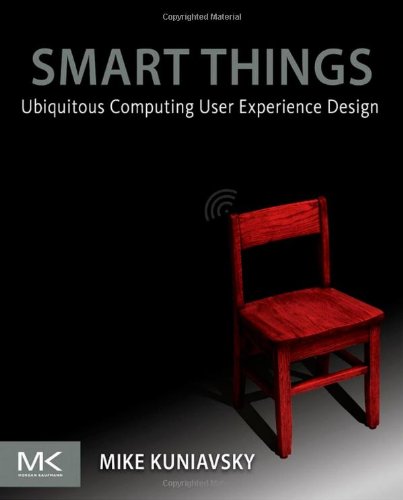

Most ebook files are in PDF format, so you can easily read them using various software such as Foxit Reader or directly on the Google Chrome browser.
Some ebook files are released by publishers in other formats such as .awz, .mobi, .epub, .fb2, etc. You may need to install specific software to read these formats on mobile/PC, such as Calibre.
Please read the tutorial at this link. https://ebooknice.com/page/post?id=faq
We offer FREE conversion to the popular formats you request; however, this may take some time. Therefore, right after payment, please email us, and we will try to provide the service as quickly as possible.
For some exceptional file formats or broken links (if any), please refrain from opening any disputes. Instead, email us first, and we will try to assist within a maximum of 6 hours.
EbookNice Team

Status:
Available4.3
9 reviews(Ebook) Smart Things Ubiquitous Computing User Experience Design 1st Edition by Mike Kuniavsky - Ebook PDF Instant Download/Delivery: 9780123748997 ,0123748992
Full download (Ebook) Smart Things Ubiquitous Computing User Experience Design 1st Edition after payment

Product details:
ISBN 10: 0123748992
ISBN 13: 9780123748997
Author: Mike Kuniavsky
The world of smart shoes, appliances, and phones is already here, but the practice of user experience (UX) design for ubiquitous computing is still relatively new. Design companies like IDEO and frogdesign are regularly asked to design products that unify software interaction, device design and service design -- which are all the key components of ubiquitous computing UX -- and practicing designers need a way to tackle practical challenges of design. Theory is not enough for them -- luckily the industry is now mature enough to have tried and tested best practices and case studies from the field.
Smart Things presents a problem-solving approach to addressing designers' needs and concentrates on process, rather than technological detail, to keep from being quickly outdated. It pays close attention to the capabilities and limitations of the medium in question and discusses the tradeoffs and challenges of design in a commercial environment. Divided into two sections, frameworks and techniques, the book discusses broad design methods and case studies that reflect key aspects of these approaches. The book then presents a set of techniques highly valuable to a practicing designer. It is intentionally not a comprehensive tutorial of user-centered design'as that is covered in many other books'but it is a handful of techniques useful when designing ubiquitous computing user experiences.
In short, Smart Things gives its readers both the "why" of this kind of design and the "how," in well-defined chunks.
* Tackles design of products in the post-Web world where computers no longer have to be monolithic, expensive general-purpose devices
* Features broad frameworks and processes, practical advice to help approach specifics, and techniques for the unique design challenges
* Presents case studies that describe, in detail, how others have solved problems, managed trade-offs, and met successes
(Ebook) Smart Things Ubiquitous Computing User Experience Design 1st Edition Table of contents:
Part I Frameworks
Chapter 1 Introduction: The Middle of Moore’s Law
1.1 The hidden middle of moore’s law
1.2 Ubiquitous computing
1.3 The need for design
Chapter 2 What is User Experience Design and, Who Creates it?
2.1 A definition of user experience
2.2 Extending garrett’s elements of user experience
2.3 Design disciplines
2.4 The importance of context
Chapter 3 Interaction Metaphors
3.1 Ubicomp User Experience Metaphors, a Catalog
3.2 Designing with Metaphors
Chapter 4 Information is a Material
4.1 A Shift in Design Thinking
4.2 Information as an Agile Material
4.3 The Properties of Information
4.4 Working with the material properties of information
Chapter 5 The Whirlpool Centralpark™ Refrigerator: The Designof an Accessory Port
5.1 A short History of the Smart Fridge
5.2 Why Did the Smart Refrigerators Fail?
5.3 Whirlpool’s Centralpark Refrigerator
5.4 Lessons From the Design Process
Chapter 6 Information Shadows
6.1 An early Success in Item-level Identification
6.2 Information Shadows
6.3 Point-at Things
6.4 The Internet of Things
6.5 Design with Information Shadows
Chapter 7 Clickables: Toys and Information Shadows
7.1 Background: Bracelets, Collectibles, and Storytelling
7.2 Clickables
Chapter 8 Devices are Service Avatars
8.1 Networks shift value to information
8.2 Devices are service avatars
8.3 Avatar and service co-design
Chapter 9 The iPod: A Service Avatar
9.1 Background: digital Music Players Before the IPod
9.2 The IPod and the itunes Service
9.3 Avatars and appliances
Chapter 10 Applianceness
10.1 Applianceness
10.2 Appliance user experience design
10.3 Conclusion
Chapter 11 Roomwizard: An Appliance for Office Society
11.1 Background
11.2 Roomwizard user experience design
11.3 Since roomwizard’s release
Chapter 12 Scales of Experience
12.1 Background: just how big is an experience?
12.2 A power-of-ten scale
12.3 Multiscale user experience design
12.4 Conclusion
Chapter 13 Plasma Poster: Unifying Work Cultures with a Digital Poster
13.1 Background: ambient multiscale community displays
13.2 Plasma poster user experience
13.3 Process
13.4 Conclusion
Part II Techniques
Chapter 14 Observation and Ideation
14.1 Observation
14.2 Ideation
Chapter 15 Simulation and Sketching
15.1 Simulation
15.2 Sketching user experiences
Chapter 16 Nabaztag, an Ambiguous Avatar
16.1 A rabbit is magic because of how it behaves
16.2 A mass-market design probe
16.3 Design principles
16.4 A device-service revenue model
16.5 Design process
16.6 User research
16.7 Desire lines
16.8 People and positions
16.9 Ambiguous success and follow-up products
Chapter 17 Augmentations and Mashups
17.1 Augmentation
17.2 Mashups between devices and web services
17.3 Conclusion
Chapter 18 Common Design Challenges
18.1 Introducing novel experiences
18.2 Design for adaptation
18.3 Creating experience continuity across avatars
18.4 Device interconnection
18.5 Respecting boundaries
Chapter 19 From Invisible Computing to Everyware
19.1 The user experience designer’s role
19.2 The user experience designer’s responsibility
19.3 What’s next?
References
Index
People also search for (Ebook) Smart Things Ubiquitous Computing User Experience Design 1st Edition:
smart things ubiquitous computing user experience design
ubiquitous computing devices
5 things that are not computing innovations
5 things that are computing innovations
smart environment in ubiquitous computing
Tags: Mike Kuniavsky, Smart Things, Ubiquitous Computing User, Experience Design